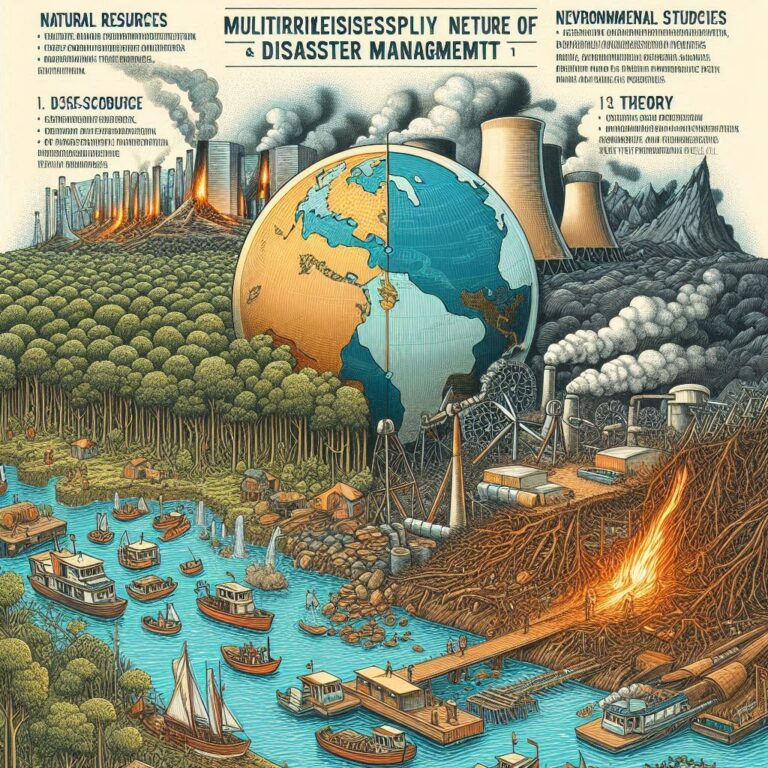Environmental Studies and Disaster Management – BSc Agriculture is an undergraduate four years program divided into eight semesters focused on the science and practice of farming and crop production. It covers a range of topics including soil science, plant biology, pest management, and agricultural economics. This degree prepares students for careers in farming, agribusiness, research, and environmental management, combining theoretical knowledge with practical skills to address global food security and sustainable agricultural practices.
| Environmental Studies and Disaster Management | Download |
BSc Agriculture 1st Semester Notes Download
BSc Agriculture Second Semester Notes Download
BSc Agriculture 3rd semester Notes Download
BSc Agriculture 4th semester Notes Download
BSc Agriculture 5th semester Notes Download
Environmental Studies and Disaster Management syllabus
Theory
Multidisciplinary nature of environmental studies Definition, scope and importance.
Natural Resources: Renewable and non-renewable resources, Natural resources and associated problems. a) Forest resources: Use and over-exploitation, deforestation, case
studies. Timber extraction, mining, dams and their effects on forest and tribal people. b) Water resources: Use and over-utilization of surface and ground water, floods, drought,
conflicts over water, dams-benefits and problems. c) Mineral resources: Use and exploitation, environmental effects of extracting and using mineral resources, case studies. d)
Food resources: World food problems, changes caused by agriculture and overgrazing, effects of modern agriculture, fertilizer-pesticide problems, water logging, salinity, case
studies. e) Energy resources: Growing energy needs, renewable and non-renewable energy sources, use of alternate energy sources. Case studies. f) Land resources: Land as a
resource, land degradation, man induced landslides, soil erosion and desertification. • Role of an individual in conservation of natural resources. • Equitable use of resources for
sustainable lifestyles.
Ecosystems: Concept of an ecosystem, Structure and function of an ecosystem, Producers, consumers and decomposers, Energy flow in the ecosystem. Ecological succession,
Food chains, food webs and ecological pyramids. Introduction, types, characteristic features, structure and function of the following ecosystem: a. Forest ecosystem b.
Grassland ecosystem c. Desert ecosystem d. Aquatic ecosystems (ponds, streams, lakes, rivers, oceans, estuaries)
Biodiversity and its conservation: – Introduction, definition, genetic, species & ecosystem diversity and biogeographical classification of India. Value of biodiversity: consumptive
use, productive use, social, ethical, aesthetic and option values. Biodiversity at global, National and local levels, India as a mega-diversity nation. Hot-sports of biodiversity.
Threats to biodiversity: habitat loss, poaching of wildlife, man-wildlife conflicts. Endangered and endemic species of India. Conservation of biodiversity: In-situ and Ex-situ
conservation of biodiversity.
Environmental Pollution: definition, cause, effects and control measures of: a. Air pollution b. Water pollution c. Soil pollution d. Marine pollution e. Noise pollution f. Thermal
pollution g. Nuclear hazards. Solid Waste Management: causes, effects and control measures of urban and industrial wastes. Role of an individual in prevention of pollution.
Social Issues and the Environment: From Unsustainable to Sustainable development, Urban problems related to energy, Water conservation, rain water harvesting, watershed
management. Environmental ethics: Issues and possible solutions, climate change, global warming, acid rain, ozone layer depletion, nuclear accidents and holocaust. dies.
Wasteland reclamation. Consumerism and waste products. Environment Protection Act. Air (Prevention and Control of Pollution) Act. Water (Prevention and control of Pollution) Act. Wildlife Protection Act. Forest Conservation Act. Issues involved in enforcement of environmental legislation. Public awareness.
Human Population and the Environment: population growth, variation among nations, population explosion, Family Welfare Programme. Environment and human health: Human
Rights, Value Education, HIV/AIDS. Women and Child Welfare. Role of Information Technology in Environment and human health.





![[PDF] BSc Agriculture Notes PDF Download All Semester](https://eagronomy.com/wp-content/uploads/2024/09/AddText_09-23-09.36.51.jpg)
![[PDF] BSc Agriculture Second Semester Notes Download](https://eagronomy.com/wp-content/uploads/2024/09/AddText_09-23-09.26.04.jpg)
![[PDF] BSc Agriculture 3rd semester Notes Download](https://eagronomy.com/wp-content/uploads/2024/09/AddText_09-23-09.27.27.jpg)